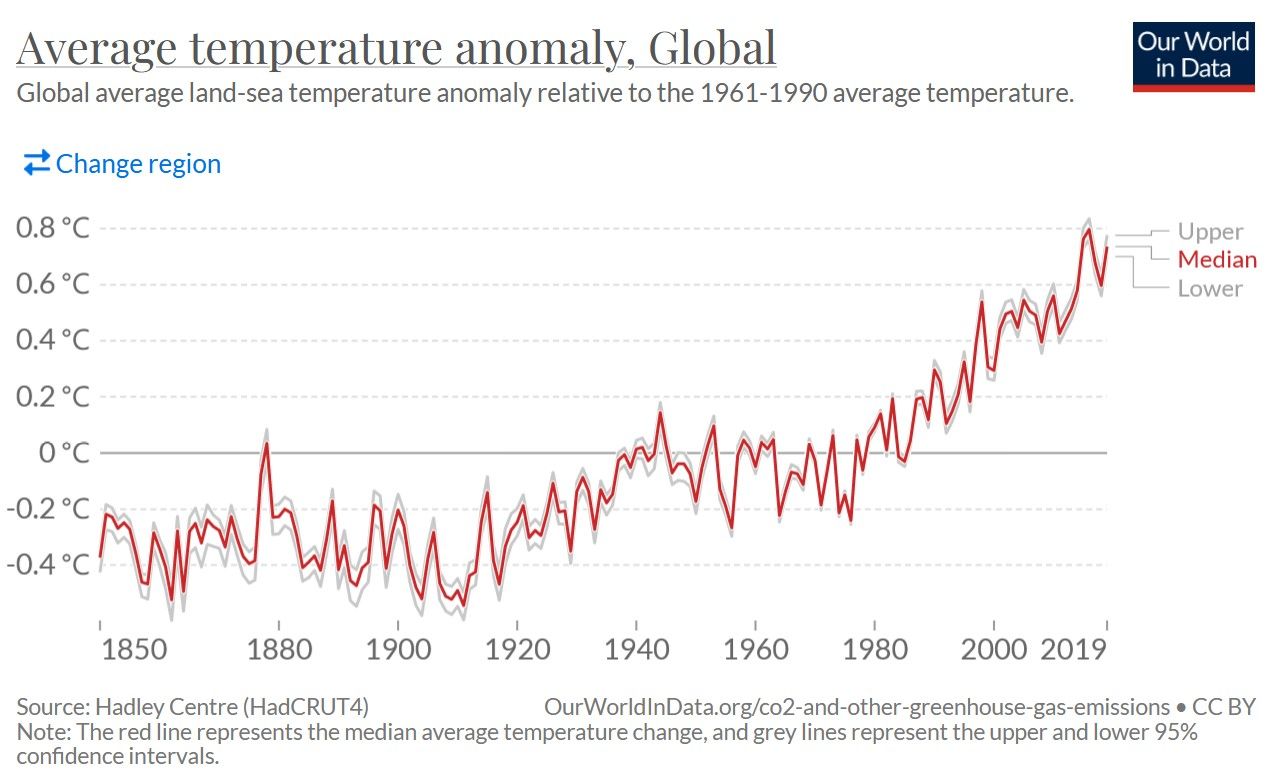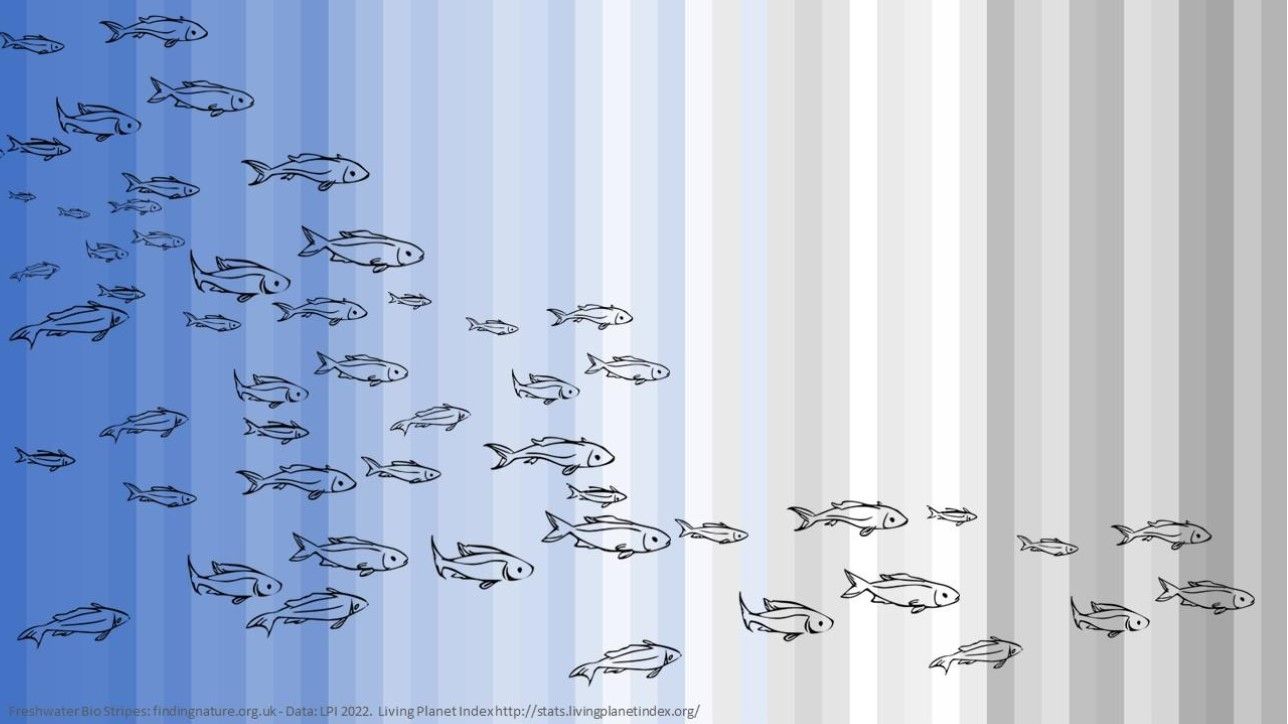· 6 min read
These stripes may remind you of others: the blue and red stripes of the climate. In 2018, climate scientist Ed Hawkins developed this sequence of stripes to represent in colour the temperature departure from normal from 1772 to 2017. Figure 1 (Hawkins, 2021).

Another way to represent global warming is to use the temperature anomaly since pre-industrial levels, compared to the average temperatures at the end of the 20th century Figure 2.

World famous, they even made the cover of The Economist in 2019. Inspired by this, Miles Richardson depicted the stripes of biodiversity to represent mass extinction and species loss. Behind this artistic representation, is a very precise goal: to raise awareness of the loss of biodiversity, a subject at least 8 times less mentioned than climate change in media (Legagneux et al., 2018), while its boundary is much more outdated that the one of climate change [Figure 3] (Prados, 2022).
Indeed, the observation seems to come later, the link with human societies seems less obvious, so the consequences seem less serious than for climate change. However, the WHO states that 'Biodiversity loss can have significant direct human health impacts if ecosystem services are no longer adequate to meet social needs. Indirectly, changes in ecosystem services affect livelihoods, income, local migration and, on occasion, may even cause or exacerbate political conflict' (WHO, 2015). Nowadays, however, we are sinking deeper into the biodiversity loss, mostly caused by humans, without even considering the consequences for our societies.
The evidence is clear: according to the Living Planet 2020 Index, the average population abundance of species has declined by 68% since 1970 (Zoological Society of London, 2022). The IPBES speaks of one million species threatened with extinction (Purvis, nd) and many scientists speak of soon entering the 6th mass extinction.
The representation of the bio-stripes highlights the most important feature of this mass extinction: its extremely rapid rate. Indeed, these stripes span less than 50 years, between 1972 and 2016, and show an extinction rate '100 to 1,000 times greater than that calculated over geological time' (Algrain, 2022).
However, in only tackling the climate, or almost, we forget the other nine planetary boundaries (Wang-Erlandsson et al., 2022). The climate frontier may have been exceeded, but it is not the one that has been pushed back the most. Indeed, the biodiversity frontier is much more worrying, and is further accentuated by climate change.

Nonetheless, climate change is only the third cause of biodiversity loss (followed by pollution and the proliferation of invasive species). The first two causes, accounting for more than half of the effects, are firstly the destruction of habitats (75% of the earth's surface has been altered by humans) and the overexploitation of resources (except for marine species, where overexploitation is the primary cause). In all, 28% of the species monitored are under threat, with fewer species and fewer individuals per species (La Fresque de la biodiversité, 2022; IPBES, 2019).
However, not all species are equally at risk of extinction: some 41% of amphibians are threatened, 26% of mammals, 37% of sharks, 34% of conifers, 33% of corals, 14% of birds, etc. Therefore, Richardson has, for example, focused on fish to show the sharp decline of marine species in a few decades [Figure 4] (Prados, 2022).

Now that we know this, what can we do as individuals?
- Getting information is the most important thing, to have in mind the orders of magnitude, to know on which actions to focus our energy and our time.
- Combating land use and the destruction of ecosystems, particularly through the artificialization of land, is of paramount importance.
- Shift to a plant-based diet, for 2 main causes. The first is that livestock farming is responsible for a large part of deforestation and soil artificialisation, and is therefore responsible for the destruction of habitats, the primary cause of biodiversity loss. The second reason is that marine biodiversity suffers primarily from overexploitation of resources: dolphins die much more from bycatch in fishing than from hunting in Asia for example (Seaspiracy, 2021).
- Getting in touch with nature, because we are much more sensitive when we look at and learn about the living beings that are dying because of our activities.
The biodiversity collage (La Fresque de la biodiversité, 2022; IPBES 2019) also adds these 4 paths to action:
- Reducing pressure on the 5 main causes of biodiversity loss.
- Recreating the conditions for life, by thinking in terms of shelter and cover.
- Contributing to knowledge about biodiversity, particularly through participatory science.
- Being amazed!
Particularly for the latter, consider that it is estimated that there are over 5 million species on Earth, but only 2 million are known, and less than 150,000 are studied. The beauty and vastness of biodiversity are not just about humans, or even the few species you have seen in a zoo. The diversity of species on Earth is beyond human imagination, and we should do everything we can to preserve it.
My personal opinion on these stripes is that they are even more impactful than the climate stripes, as they fade and show a world that is losing its colours and dying. Humans are part of the Living, and don't realise that if the Living dies, they die with them. However, we now know the facts, and we know how to take action: educating ourselves and raising awareness around us are the first steps to changing the world and fighting for the preservation of Life.
Future Thought Leaders is a democratic space presenting the thoughts and opinions of rising Sustainability & Energy writers, their opinions do not necessarily represent those of illuminem.
References
ALGRAIN S., 2022. [LinkedIn] August 2022 [viewed 17 August 2022] Available from: https://www.linkedin.com/posts/stacy-algrain_showyourstripes-activity-6965617173666873344-jgU4?utm_source=linkedin_share&utm_medium=member_desktop_web (French)
HAWKINS, 2021. Show your stripes [online] University of reading [viewed 17 August 2022] Available from: https://showyourstripes.info/s/globe
La fresque de la biodiversité, 2022. [viewed 13 December 2021] Available from : https://www.fresquedelabiodiversite.org/ (French)
LEGAGNEUX P., CASAJUS N., CAZELLES K., CHEVALLIER C., CHEVRINAIS M., GUERY L., JACQUET C., JAFFRE M., NAUD M.J., NOISETTE F., ROPARS P., VISSAULT S., ARCHAMBAULT P., BETY J., BERTEAUX D., GRAVEL D., 2018. Our House Is Burning: Discrepancy in Climate Change vs. Biodiversity Coverage in the Media as Compared to Scientific Literature. Frontiers in Ecology and Evolution [online] 5 [viewed 17 August 2022] Available from: https://www.frontiersin.org/articles/10.3389/fevo.2017.00175
OUR WORLD IN DATA, 2019. Average temperature anomaly, global. [online] Our World in data [viewed 19 August 2022] Available from: https://ourworldindata.org/grapher/temperature-anomaly?country=~Global
PRADOS J., 2022. À l’image des « bandes du réchauffement climatique », un nouvel outil pour mieux (se) représenter l’effondrement du vivant [Like the "global warming stripes", a new tool to better represent the collapse of life] [online] Vert [viewed 17 August 2022] Available from : https://vert.eco/articles/a-limage-des-bandes-du-rechauffement-climatique-un-nouvel-outil-pour-mieux-se-representer-leffondrement-de-la-biodiversite
PURVIS A., nd. A million threatened species? Thirteen questions and answers [online] IPBES [viewed 17 August 2022] Available from: https://ipbes.net/news/million-threatened-species-thirteen-questions-answers
SEASPIRACY, 2021. [Netflix] Available from: https://www.seaspiracy.org/
WANG-ERLANDSSON, L., TOBIAN, A., VAN DER ENT, R. J., FETZER, I., TE WIERIK, S., PORKKA, M., STAAL, A., JARAMILLO, F., DAHLMANN, H., SINGH, C., GREVE, P., GERTEN, D., KEYS, P.W., GLEESON, T, CORNELL, S. E., STEFFEN, W., BAI, X., ROCKSTRÖM, J., (2022). Towards a green water planetary boundary. Nature Reviews Earth & Environment. [online] [viewed 17 August 2022] Available from: https://doi.org/10.1038/s43017-022-00287-8
WHO, 2015. Biodiversity and Health [online] World Health Organization [viewed 17 August 2022] Available from: https://www.who.int/news-room/fact-sheets/detail/biodiversity-and-health
ZOOLOGICAL SOCIETY OF LONDON, 2020. Living Planet Index [online] [viewed 17 August 2022] Available from: http://stats.livingplanetindex.org/






